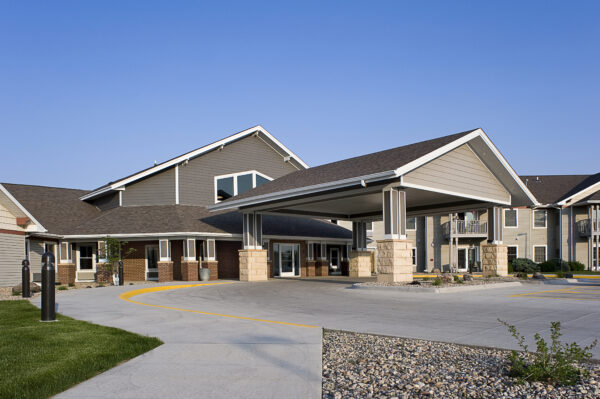The South Dakota Association of Healthcare Organizations (SDAHO) would like to thank and recognize McGough Construction for being a sponsor at this year’s Rural Health Leaders (RHL) Conference. We are thankful for the ongoing support from McGough Construction, as their sponsorship enables SDAHO to offer opportunities like RHL to our members.
By McGough Construction
Rural hospitals and healthcare facilities are critical to their communities, serving as a key point of access to care for nearly 20% of the U.S. population. In addition, rural hospitals supported one in every 12 rural jobs in 2020 as well as $220 billion in economic activity in rural communities, according to the American Hospital Association.
But healthcare facilities in rural areas face numerous challenges that threaten their futures. Obstacles include older patient populations, aging facilities, staffing shortages and a lack of resources. As rural healthcare operations look for ways to address these issues, facility upgrades, remodels or expansions can make them more competitive and help attract more patients and workers.
However, for many facilities, funding is a challenge for such projects. One option to consider is the Community Facilities Direct Loan & Grant program through the U.S. Department of Agriculture (USDA). The program funds construction, expansion and remodeling of essential community facilities in rural areas — including such healthcare resources as hospitals, medical and dental clinics, nursing homes and assisted living facilities.
A growing number of rural operations are taking advantage of this program. It offers a crucial source of project funding, so it’s important to understand the benefits and drawbacks.
How does USDA funding work?
For several decades, the Community Facilities program has offered direct loans, loan guarantees and grants to develop or improve essential public services and facilities in rural areas. It is growing in popularity as more rural institutions struggle with costs and funding and as it becomes more expensive to borrow money through commercial lending channels.
The program’s aim is to help increase the competitiveness of rural communities in attracting and retaining businesses that provide employment and services to residents. Public bodies and community-based nonprofit organizations can apply for loans or grants for new construction or to expand or improve existing structures for healthcare, education, public safety or public services. The money can also be used to cover land acquisition, equipment purchases and professional fees for such projects.
To be eligible, a facility must be in a rural area where the city, town or township has fewer than 20,000 residents. The application and approval process with USDA also requires a certain level of community support and involves an in-depth review of the organization’s financials to ensure that they can pay back the loan.
Benefits of USDA funding
The Community Facilities program is a popular form of funding because of its low interest rates and long repayment terms — up to 40 years to repay in some cases. Also, the interest rate is fixed for the entire loan term at a rate that is determined based on the median household income of the service area and community population of the facility. Current interest rates (June 2024) range from 3.5% to 4% intermediate, for example.
These low interest rates and long repayment terms can save facilities significant amounts of money compared to commercial loan options, especially on larger projects. For some, the USDA program may be the only funding option and the only way they are able to complete these types of projects.
Factors to consider
While the program can deliver substantial benefits for many rural facilities, there are some challenges to consider when applying for the funding.
The application and approval process can be lengthy and requires many steps. It includes an in-depth financial audit and typically requires demonstration of community support and other funding sources for the project. If timing is a concern and a project must be completed quickly, this can be a hurdle. It’s important to build enough time into the project timeline for the application process and review; plan on an integrated planning and design process of 12 to 16 months when seeking USDA funding.
The program falls under the Build America Buy America Act, which states that government-funded building projects must use materials made in the United States. Because of this, the program may limit the materials that facilities can use, which could result in project delays and cost increases if there are shortages or supply chain issues.
Finally, for facilities that are choosing to go with a Construction Manager, they must go through a competitive selection process that will need to include all required USDA documentation, and must follow the specific USDA steps and guidelines, which can add complexity to the process.
Choose an experienced partner
One way that facilities can make the process easier is to work with a local construction management company or lending adviser with experience in projects that use USDA funding. Choosing a local or regional partner is especially key since many states have different rules for such projects. An experienced partner can guide facilities through the application and review process to ensure that all proper documentation is submitted and necessary steps are met. This helps avoid potential delays that could add months and significant costs to a project.
Despite the steps that facilities must take to pursue USDA funding, in most cases it is worth the extra time and effort — especially for rural healthcare facilities that could not fund projects through other means. Since most rural hospitals are county-owned, USDA financing is often an attractive option for funding expansions and renovations.
Learn more about McGough by clicking here.
Customer Success Story: Sioux Center Health

Sioux Center Health, a nonprofit health facility in Sioux Center, Iowa, wanted to expand and renovate its facilities with a $28 million project to better meet community needs. The facility, located in the rural northwest corner of the state, sought U.S. Department of Agriculture funding to help finance the major project.
Seven distinct projects were incorporated into the expansion and renovation of the active healthcare campus. These included:
- The addition of 24 skilled care and 16 memory care rooms to the assisted living facility, with common spaces sprinkled throughout each wing addition.
- A 26,000-square-foot addition to the existing skilled nursing area to help solve the issue of overcrowding.
- Renovation and expansion of the facility’s main entrance, registration and multi-use area — designed to improve foot traffic flow between all resident areas (memory, skilled and assisted living).
- Renovations to the main kitchen, dining area and central café.
- An additional 32 parking spaces to accommodate the expanding resident base.
- An additional 7,200 square feet to the existing hospital-based clinics of the Family Practice and Specialty Clinic area, including the addition of 18 exam rooms. This portion used modular-base construction within the exam rooms to improve future flexibility.
- Construction of a 6,000-square-foot medical office building near the existing hospital to house various outpatient services on campus.
Sioux Center Health received a USDA loan of $25 million toward the project and undertook a capital campaign to raise additional money. The facility worked with McGough to guide them through the USDA application process. McGough has completed several USDA-financed projects, bringing critical experience to the table. One learning lesson after working on several USDA-funded initiatives: Communication and documentation are key to a smooth process.
Click here to learn more about other McGough Construction healthcare projects.




